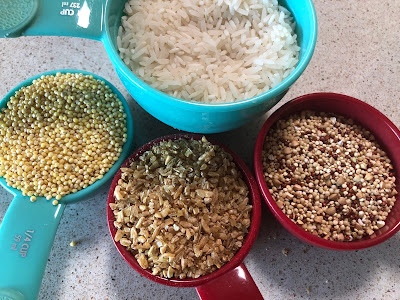
Recipe: Healthy grains are the base for flexible pilaf recipe

Grate tomato halves for the cooking sauce for multigrain pilaf. (Photos: Kathy Morrison)
|

The rich flavor of these Cherokee Carbon tomatoes was perfect
for the pilaf.
|
August is when I start looking for other ways to use my tomato bounty. I've had several BLTs and caprese salads, made cobbler, and I've doused grilled salmon in tomato-basil vinaigrette. I'll get to my usual tomato canning later this month.
In between, I've found a great way to use tomatoes in an easy side dish. This multigrain combo can easily be adapted to whatever flavor profile you want, to accompany tacos, chicken tikka or beef kabobs. A large-hole cheese grater is the only fancy equipment you need, and you don't have to strain out the seeds -- they become part of the texture of the dish.
Note that the grains can be varied, but I would keep basmati or jasmine rice as the main one. The others are up to you and your pantry contents.
Four-Grain and Tomato Pilaf
Adapted from "You Say Tomato" by Joanne Weir
Serves 6

Basmati rice, top, and from left, millet, freekah and quinoa
blend went into my version of this pilaf.
|
Ingredients:
3 medium ripe red tomatoes
1 tablespoon canola or vegetable oil
3/4 cup basmati or jasmine rice
1/4 cup quinoa or quinoa blend
1/4 cup millet or bulgur wheat
1/4 cup freekah or amaranth
1/2 teaspoon or more fresh thyme, plus more for garnish, or 1/2 teaspoon ground cumin
1 or 2 shallots, minced
Optional addition: 4-ounce can chopped chilies, drained
1 cup vegetable or chicken stock
Coarse salt and freshly ground black pepper

|
Instructions:
Cut the tomatoes in half. Cup each tomato half in your hand, cut side out, and, using the large holes of a grater, grate the tomato into a bowl. Discard or compost the skins.
Heat the oil in a large saucepan over medium heat. Add the rice and your selection of other grains (the four together should total 1 1/2 cups), and the thyme or cumin and shallots. Stir until the grains are coated and hot, 1 to 2 minutes.
Increase the heat to high and add the stock, 1 1/2 cups water, the tomato juice and pulp, the chilies if using, 3/4 teaspoon salt, and pepper to taste. Bring to a boil, reduce the heat to low, and simmer, covered, until the grains are tender and the liquid is absorbed, about 25 minutes.
Fluff with a fork. Correct the seasonings. Serve, garnished with more thyme or garnish of your choice.
Comments
0 comments have been posted.Sacramento Digs Gardening to your inbox.
Sites We Like
Garden Checklist for week of May 12
Get your gardening chores and irrigation done early in the day before temperatures rise.
* Plant, plant, plant! It’s prime planting season in the Sacramento area. Time to set out those tomato transplants along with peppers and eggplants. Pinch off any flowers on new transplants to make them concentrate on establishing roots instead of setting premature fruit.
* Direct-seed melons, cucumbers, summer squash, corn, radishes, pumpkins and annual herbs such as basil.
* Harvest cabbage, lettuce, peas and green onions. This heat will cause leafy greens and onions to flower; pick them before they bolt.
* In the flower garden, direct-seed sunflowers, cosmos, salvia, zinnias, marigolds, celosia and asters.
* Plant dahlia tubers. Other perennials to set out include verbena, coreopsis, coneflower and astilbe.
* Transplant petunias, marigolds and perennial flowers such as astilbe, columbine, coneflowers, coreopsis, dahlias, rudbeckia and verbena.
* Keep an eye out for slugs, snails, earwigs and aphids that want to dine on tender new growth.
* Feed summer bloomers with a balanced fertilizer.
* For continued bloom, cut off spent flowers on roses as well as other flowering plants.
* Got fruit trees? If you haven't already done so, thin orchard fruit such as apples, peaches, pears, pluots and plums before they grow too heavy, breaking branches or even splitting the tree. Leave the largest fruit on the branch, culling the smaller ones, and allow for 5 to 6 inches (or a hand's worth) between each fruit.
* Thin grape bunches, again leaving about 6 inches between them. For the remaining bunches, prune off the "tail" end, about the bottom third of the bunch, so that the plant's energy is concentrated in the fruit closest to the branch.
* As spring-flowering shrubs finish blooming, give them a little pruning to shape them, removing old and dead wood. Lightly trim azaleas, fuchsias and marguerites for bushier plants.
* Add mulch to the garden to help keep that precious water from evaporating. Mulch also cuts down on weeds. But don’t let it mound around the stems or trunks of trees or shrubs. Leave about a 6-inch to 1-foot circle to avoid crown rot or other problems.